Explore London’s hidden luxury gems like the stunning Leighton House Museum, which showcases Victorian artistry and exotic architecture, and Highgate Cemetery, with its Gothic tombs and spiritual symbols. Discover unique spots like the Museum of Brands and the historic 575 Wandsworth Road, beautifully preserved folk art homes. Experience the charm of Wilton’s Music Hall and vibrant artistic communities on Eel Pie Island. Continue discovering the city’s rich history and secrets that make London truly special.
Key Takeaways
- Explore Leighton House Museum’s Victorian art and Middle Eastern-inspired Arab Hall for an authentic, luxurious cultural experience.
- Discover Highgate Cemetery’s ornate Gothic tombs and Egyptian vaults, showcasing Victorian craftsmanship and unique burial customs.
- Visit the Museum of Brands to see vintage packaging designs reflecting Britain’s evolving consumer culture and creative history.
- Experience Eel Pie Island’s thriving artistic community with exclusive workshops and private art events in a hidden riverside setting.
- Attend performances at Wilton’s Music Hall, London’s oldest Victorian entertainment venue, blending historic charm with modern luxury.
Discovering Artistic Retreats: Leighton House Museum
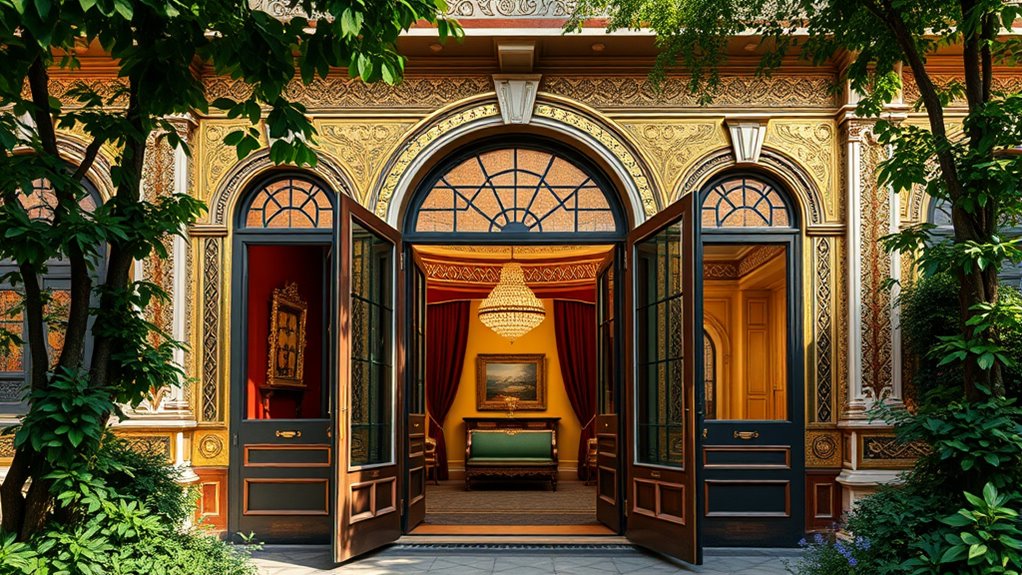
If you’re interested in exploring London’s rich artistic heritage, visiting Leighton House Museum offers a unique glimpse into Victorian creativity. Inside, you’ll find impressionist interiors that reflect Leighton’s eclectic taste and artistic influences. The house’s standout feature is the Arab Hall, inspired by Middle Eastern mosaics and architecture, showcasing intricate tiles from Damascus and a stunning two-storey design. As you walk through, you’ll notice the blend of classical architecture with exotic Middle Eastern elements, creating a vibrant, immersive atmosphere. This space was designed to inspire artistic expression and serve as a hub for Victorian artists. Leighton House’s rich decoration and historical significance make it a must-visit for art lovers seeking an authentic, artistic retreat in the heart of London. Regular maintenance and careful preservation efforts ensure that the house remains an artistic heritage site for future generations to enjoy.
Exploring Victorian Elegance: Highgate Cemetery

As you explore Highgate Cemetery, you’ll notice the striking Victorian funeral art that adorns many tombs, blending symbolism and craftsmanship. You’ll also come across the resting places of notable figures whose memorials reflect the period’s elaborate architectural style. Keep your eyes open for intricate details like Gothic carvings and Egyptian motifs that make this cemetery a true showcase of Victorian elegance. The use of vintage decor and antique elements throughout the cemetery further enhances its timeless charm.
Victorian Funeral Art
Have you ever noticed how Victorian funeral art at Highgate Cemetery embodies a blend of elegance and symbolism? The tombs and monuments showcase intricate Gothic designs, reflecting Victorian mourning customs and funerary symbolism. You’ll see statues of angels, mourning figures, and allegorical motifs that express grief and hope. The use of crypts, vaults, and symbolic sculptures creates a romantic, dramatic atmosphere. Here’s a glimpse of some common symbols:
| Symbol | Meaning | Style |
|---|---|---|
| Cross | Faith and resurrection | Gothic |
| Wings | Ascension and protection | Angelic |
| Laurel | Honor and victory | Classical |
| Lotus | Purity, rebirth | Egyptian Revival |
These elements highlight how Victorian funeral art combines aesthetic sophistication with deep spiritual meaning. The artistic craftsmanship evident in these sculptures demonstrates the Victorian era’s emphasis on detailed and expressive design. Highgate Cemetery’s rich collection of funerary sculptures provides an exceptional example of Victorian craftsmanship and artistry.
Notable Resting Places
Highgate Cemetery stands as proof of Victorian elegance, housing the final resting places of many notable figures whose lives shaped London’s cultural and intellectual landscape. The cemetery’s symbolism reflects Victorian burial customs, emphasizing honor and remembrance through elaborate tombs and monuments. As you walk among the graves of artists, writers, and public figures, you’ll notice the intricate symbolism embedded in their memorials—each telling a story about their lives or beliefs. Burial customs of the era favored grand, ornate tombs, often incorporating Gothic or Egyptian influences, which signified status and respect. The cemetery’s design and monuments serve as a testament to Victorian attitudes toward mortality and remembrance, making it a enthralling glimpse into the city’s rich history and the cultural significance placed on resting places. Many graves feature elaborate sculptures and inscriptions, showcasing Victorian craftsmanship and artistic expression. Exploring these memorials can inspire reflection on the legacy of influential figures, encouraging personal growth and appreciation for history.
Architectural Details
The architectural details of Highgate Cemetery vividly showcase Victorian elegance through a striking mix of styles that reflect the era’s fascination with history and symbolism. The Neo-Gothic architecture, characteristic of Gothic Revival, dominates with pointed arches, intricate tracery, and ornate detailing, evoking medieval grandeur. You’ll notice the Egyptian Vaults along the Egyptian Avenue, inspired by Victorian Egyptology, with their distinctive hieroglyphs and imposing stonework. The cemetery’s chapels feature Tudor Gothic elements, topped with wooden turrets and a central bell tower, adding to the eclectic mix. The Circle of Lebanon combines classical influences with Egyptian motifs, creating a unique visual harmony. These architectural features, set within a landscape of winding paths and Rococo touches, create an atmosphere of Victorian splendor and timeless elegance. Additionally, the use of cybersecurity vulnerabilities during past disruptions highlights the importance of safeguarding such historic sites against modern digital threats.
Unique Treasures at the Museum Of Brands

At the Museum of Brands, you’ll discover how packaging has evolved over the years, revealing changing tastes and technological advances. The retro design highlights, like vintage cereal boxes and biscuit tins, showcase creativity from different eras. These treasures offer a fascinating glimpse into Britain’s consumer culture and branding history. Founded in 1984 by consumer historian Robert Opie, the museum provides a comprehensive look into the history of branding in Britain. Exploring these vintage items can also serve as a form of mindful decluttering, helping visitors appreciate the value of preserving historical artifacts while understanding the importance of responsible consumption.
Vintage Packaging Evolution
Vintage packaging tells a fascinating story of technological innovation, cultural shifts, and evolving consumer tastes. The design evolution reflects how brands adapted from Victorian-era hygiene concerns to modern aesthetics. Early vintage packaging used simple containers, but innovations like Bavarian color printing allowed for elaborate, colorful designs—especially for chocolates introduced around 1868. Over time, packaging simplified for mass production, shifting toward minimalistic styles that still maintained brand identity through technological advances. Iconic brands like Bovril and Colman’s Mustard evolved their packaging while preserving legacy elements, illustrating a careful balance between tradition and progress. At the Museum of Brands, you’ll see how packaging became a cultural artifact, evoking nostalgia and societal values, showcasing the continuous transformation of how products are presented to consumers. Additionally, the packaging evolution highlights how technological advances influenced manufacturing and design choices over the decades.
Retro Design Highlights
Exploring the Museum of Brands reveals a mesmerizing journey through 200 years of British consumer culture, where design tells stories of societal change and lifestyle shifts. The Retro Design Highlights showcase retro branding and packaging evolution, illustrating how iconic brands like Bovril, Colman’s Mustard, and Dettol adapted their visual identities over time. You’ll see how packaging design balances tradition with innovation, reflecting advances in technology and consumer preferences. The exhibits include vintage biscuit tins and nostalgic advertising that reveal the aesthetic styles of different eras. Through immersive soundtracks and photogenic displays, the museum captures the essence of each period’s design trends. This collection highlights how branding and packaging serve as cultural artifacts, revealing insights into Britain’s social history and evolving market trends. Packaging design also demonstrates how visual elements influence consumer perception and brand loyalty over generations.
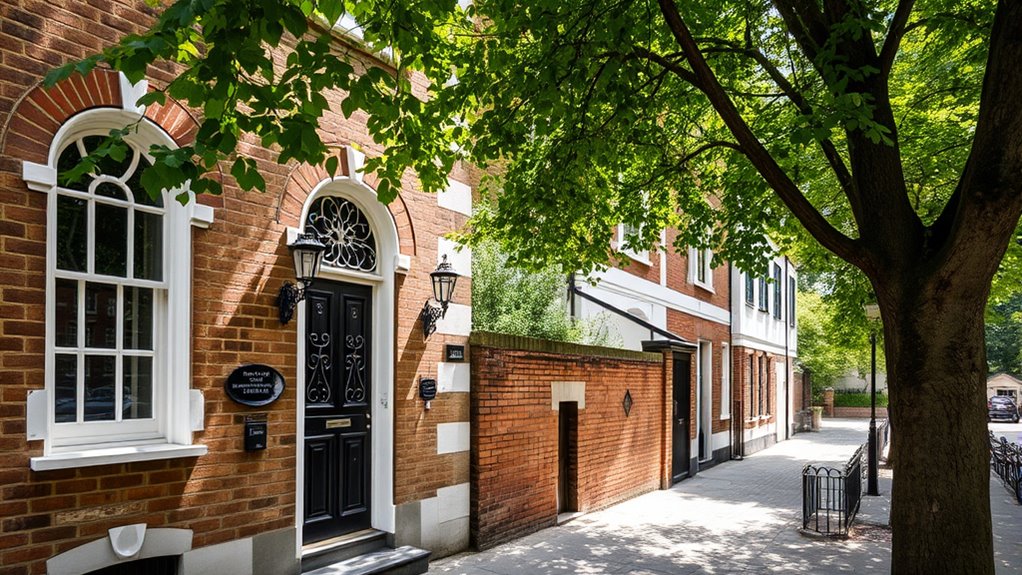
Have you ever wondered how a historic London townhouse can become a stunning canvas of cross-cultural artistry? 575 Wandsworth Road, a Grade II listed Georgian terraced house, offers a fascinating glimpse into London’s layered history and creative transformation. Its simple Georgian exterior contrasts with an interior rich in cross-cultural motifs, blending African, Islamic, and British decorative traditions. Once dilapidated, Khadambi Asalache’s meticulous hand-carved fretwork transformed the home into a folk art masterpiece, creating an artistic ambiance unlike any other. Preserved by the National Trust, the house’s authenticity remains intact, offering visitors a rare chance to experience hidden heritage in an immersive environment. The house’s historic lane, Matrimony Place, adds to its unique charm and cultural significance. Understanding preservation ensures that such sites continue to inspire future generations.
Experiencing London’s Oldest Music Hall: Wilton’s Music Hall
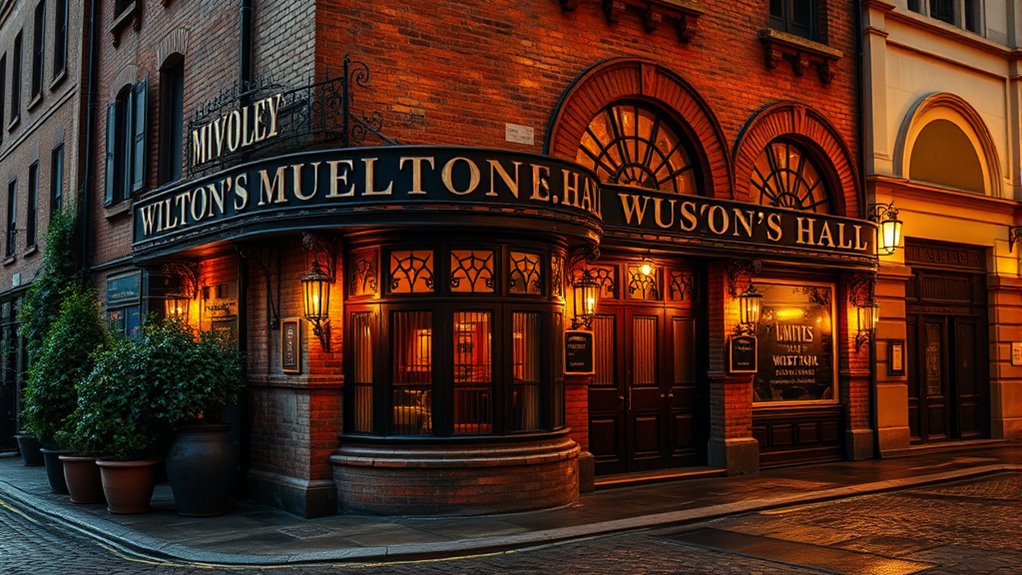
Step inside Wilton’s Music Hall, London’s oldest surviving Victorian entertainment venue, and you’re stepping into a living piece of history. This Grade II* listed building, dating back to 1743, blends 18th-century architecture with 19th-century grandeur. Originally built as an alehouse, it evolved into a lively music hall that hosted famous performers like George Leybourne. The hall’s ornate features—barley twist columns, gas chandeliers, and decorative paintwork—showcase superb historic preservation efforts. Its resilience through fire and neglect highlights its cultural importance. Today, Wilton’s continues to serve as a vibrant arts space, celebrating its past while entertaining new generations. Preserving historic architecture plays a crucial role in maintaining its charm and historical significance.
Artistic Havens on Eel Pie Island
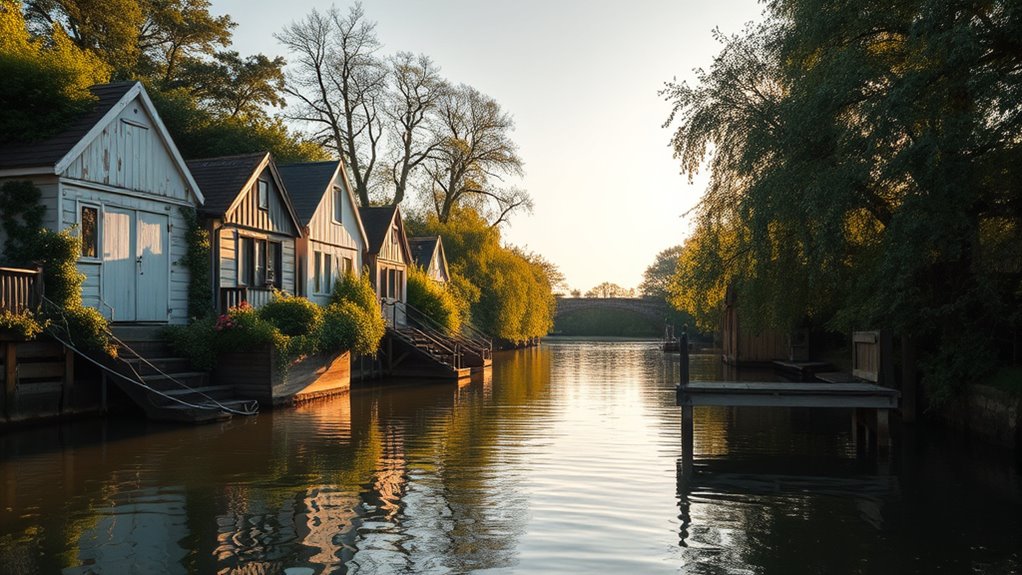
Nestled in the River Thames, Eel Pie Island has cultivated a vibrant artistic community that continues to thrive today. The island’s boatyards have been transformed into creative workshops where island artists produce unique works, from sculpture to mixed media. Residents run studios and independent art businesses, contributing to the island’s quirky, creative vibe. Notable artists, like the duo behind Love Shack and Bitter & Twisted, add to this lively scene, while sculptor Emily Young has personal ties to the island’s artistic heritage. The community hosts art events and private commissions, keeping the island’s reputation as a hidden artistic haven alive. Additionally, the island’s innovative automation in business supports its artistic endeavors by streamlining operations and enabling artists to focus more on their craft. Accessible by footbridge or boat, Eel Pie Island remains a private, inspiring space where waterway living and creative enterprise intersect seamlessly.
The Art and Architecture of the Wallace Collection
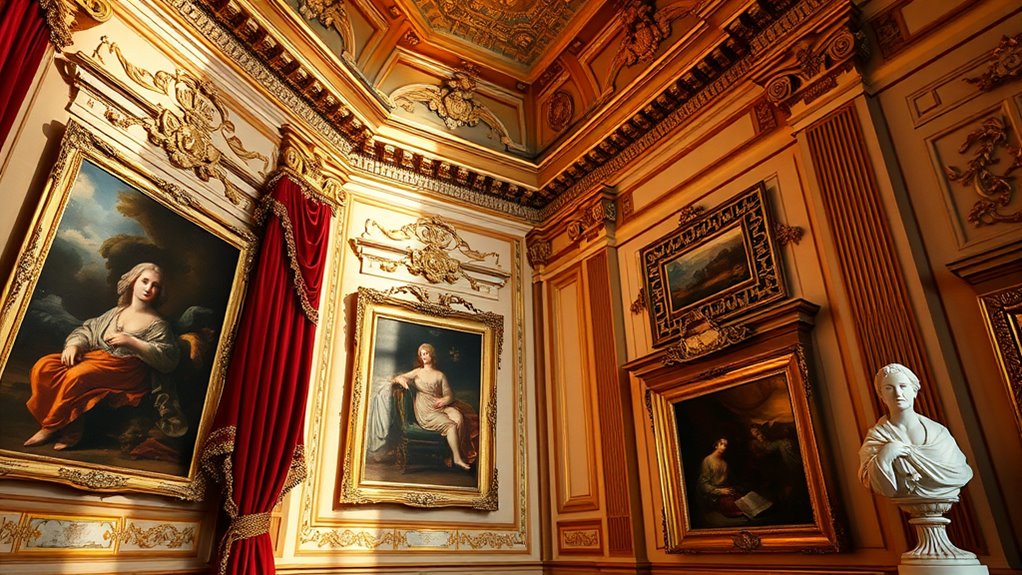
Ever wondered what makes the Wallace Collection’s architecture so mesmerizing? It’s the seamless blend of French grandeur and aristocratic interiors that transports you to another era. Hertford House, built in the 18th century, once served as French and Spanish embassies, now beautifully renovated to preserve its historic charm. As you explore, you’ll notice:
- The grand staircase and spacious entrance hall exude luxury.
- Rooms themed around specific historical periods deepen your connection to the art.
- The central courtyard, now a lavish restaurant, maintains the house’s stately ambiance.
- The blend of French and English styles reflects aristocratic tastes.
- The intimate gallery spaces mirror private 19th-century collections, enriching your experience.
This architectural elegance sets the perfect stage for the extraordinary collection within. Architectural styles also emphasize the building’s historic significance and aesthetic appeal.
Royal Heritage and Architectural Marvels: Westminster Abbey

Westminster Abbey has stood at the heart of British history for over a millennium, serving as a symbol of royal power and national identity. Its rich historical symbolism is woven into its origins, dating back to 960 AD, and its role in coronations, royal weddings, and funerals. The Abbey exemplifies Gothic craftsmanship, with pointed arches, rib vaults, and flying buttresses supporting its soaring nave and intricate design. The Henry VII Chapel, a late Gothic masterpiece, highlights England’s architectural evolution, blending medieval style with unique elements like West towers influenced by Baroque architecture. Its majestic scale and detailed features, such as stained glass rose windows and geometric patterns, make Westminster Abbey a living monument to Britain’s monarchy and architectural heritage. Additionally, Gothic craftsmanship emphasizes the skill and artistry involved in creating its stunning structural details.
Vibrant Markets and Street Art: Camden Market
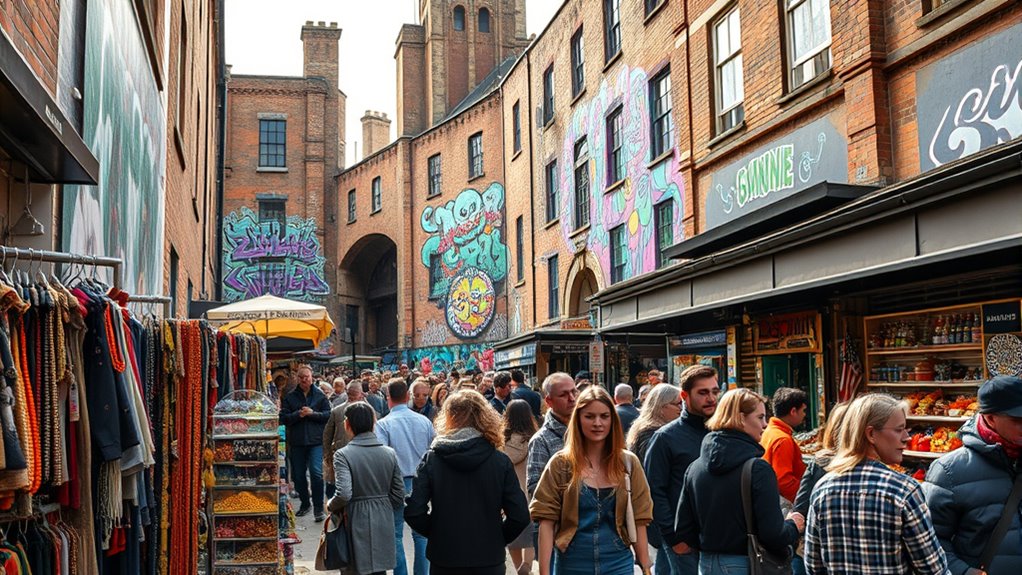
Camden Market has become a vibrant hub of creativity and diversity, attracting visitors from around the world with its eclectic mix of shops, street food, and artistic expression. Its lively street art scene, featuring murals and graffiti, reflects social and cultural themes, making it a key part of Camden’s identity. The market’s diversity extends beyond products to include bold visual statements that transform the area into an open-air gallery, engaging visitors beyond shopping. The street art often merges seamlessly with market events and performances, creating a dynamic urban atmosphere. As a hub for independent artists and street culture, Camden’s murals serve as landmarks and photo spots, capturing the essence of London’s alternative scene. Incorporating artistic expression into the urban environment enhances the market’s appeal and highlights its role as a showcase for creative talent.
Frequently Asked Questions
How Can I Access Private Tours of London’s Hidden Gems?
You can access private tours of London’s hidden gems through private tour providers like Viator and TripAdvisor, which offer tailored experiences with local guides. Book in advance to secure exclusive access experiences, especially during peak seasons. These providers often customize itineraries, include luxury extras, and provide flexible options. Make sure to check for additional costs and confirm your booking online for a seamless, memorable journey exploring London’s best-kept secrets.
What Are the Best Luxury Accommodations Near These Sites?
You’re about to discover the ultimate luxury stay in London, where your experience feels like a royal affair! Luxury boutique hotels and private villa rentals near iconic sites like St. Paul’s or Hyde Park turn your trip into an indulgent escape. Imagine waking up in stylish, historic surroundings, just steps from London’s hidden treasures. These accommodations elevate your visit, blending exclusivity with authentic local charm for an unforgettable adventure.
Are There Exclusive Dining Options Close to Wilton’S Music Hall?
You’ll find plenty of exclusive dining options near Wilton’s Music Hall. Indulge in luxury afternoon tea at elegant venues like Côte Brasserie, or explore historic pubs with refined atmospheres, offering gourmet meals and fine wines. Many restaurants here feature upscale decor and curated menus, perfect for a sophisticated experience. Reservations are recommended, especially for popular spots, to enjoy the best of London’s luxury dining close to Wilton’s Music Hall.
How Do I Visit Highgate Cemetery With a Private Guide?
Imagine stepping into London’s shadowy past with a private guide at Highgate Cemetery, where history whispers from every stone. To do this, you’ll need to pre-book through the official website or specialized operators like Black Cab Tours. The guided tour benefits include exclusive access to the West Cemetery, detailed stories of famous burials, and personal attention. Remember, booking in advance maintains this historic site and ensures a tailored, immersive experience.
What Transportation Options Are Recommended for Exploring These Hidden Spots?
When exploring hidden spots, you have a few options. Public transportation is affordable and convenient, but it might be crowded or limited to certain routes. For a more luxurious experience, a premium chauffeur service is ideal. It offers door-to-door comfort, access to lesser-known locations, and personalized itineraries. With a luxury chauffeur, you can relax, avoid crowds, and enjoy a tailored, stress-free journey to the UK’s secret gems.
Conclusion
London truly offers over 300 hidden gems that let you experience the city like a local. From secret art retreats to historic homes, you’ll find endless treasures tucked away from the crowds. Did you know that Camden Market attracts over 20 million visitors annually? So, step off the beaten path and immerse yourself in London’s vibrant, luxurious side—you’ll leave with unforgettable memories and a deeper connection to this extraordinary city.









